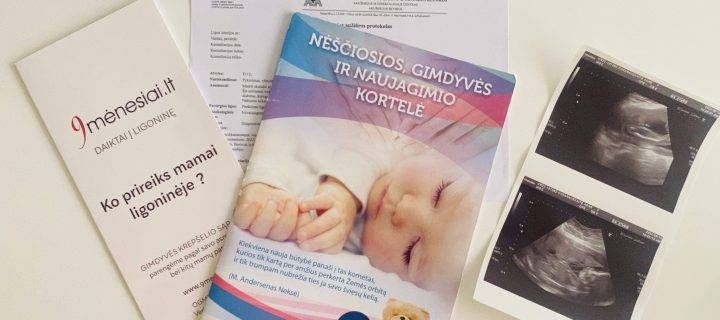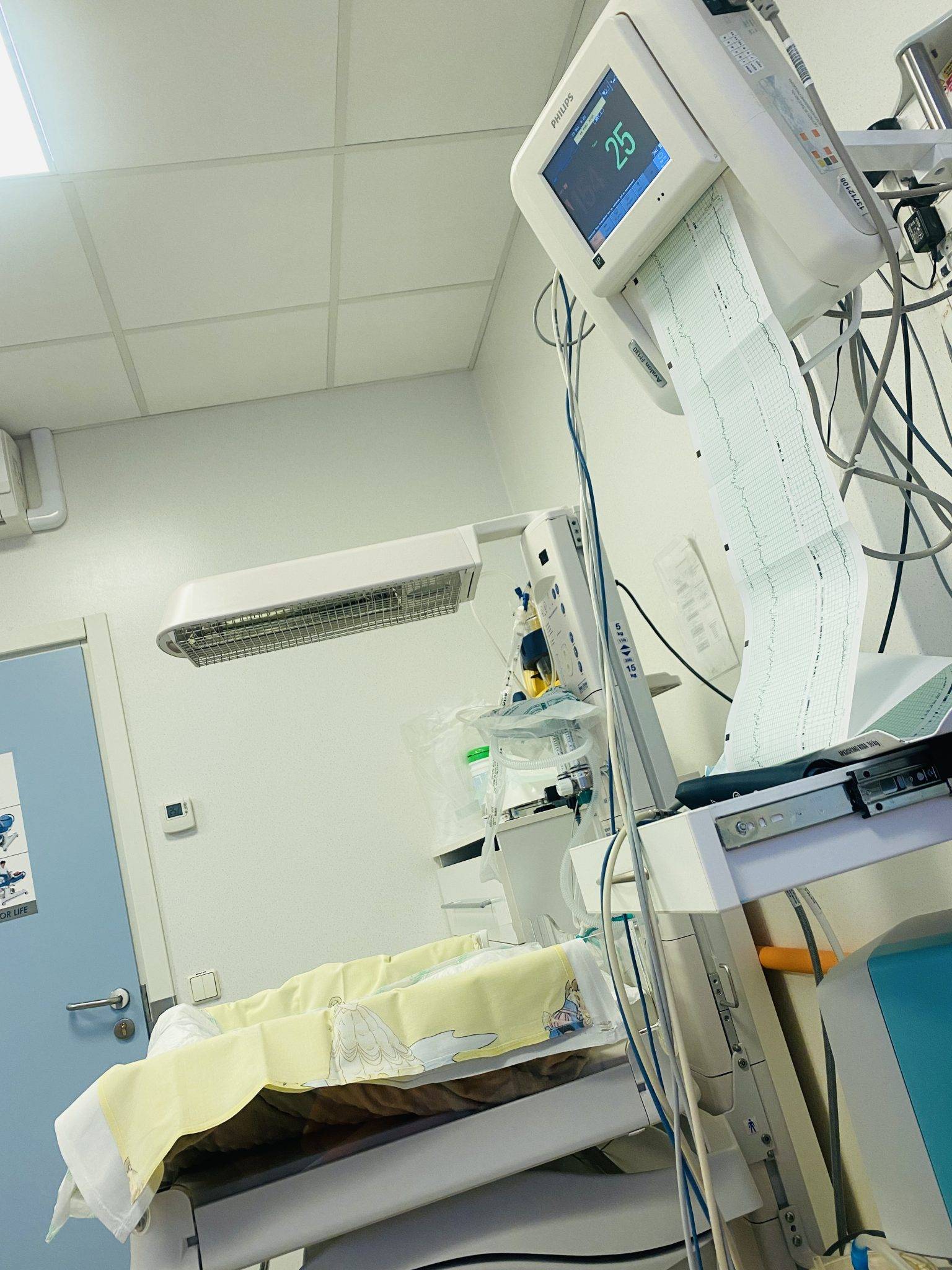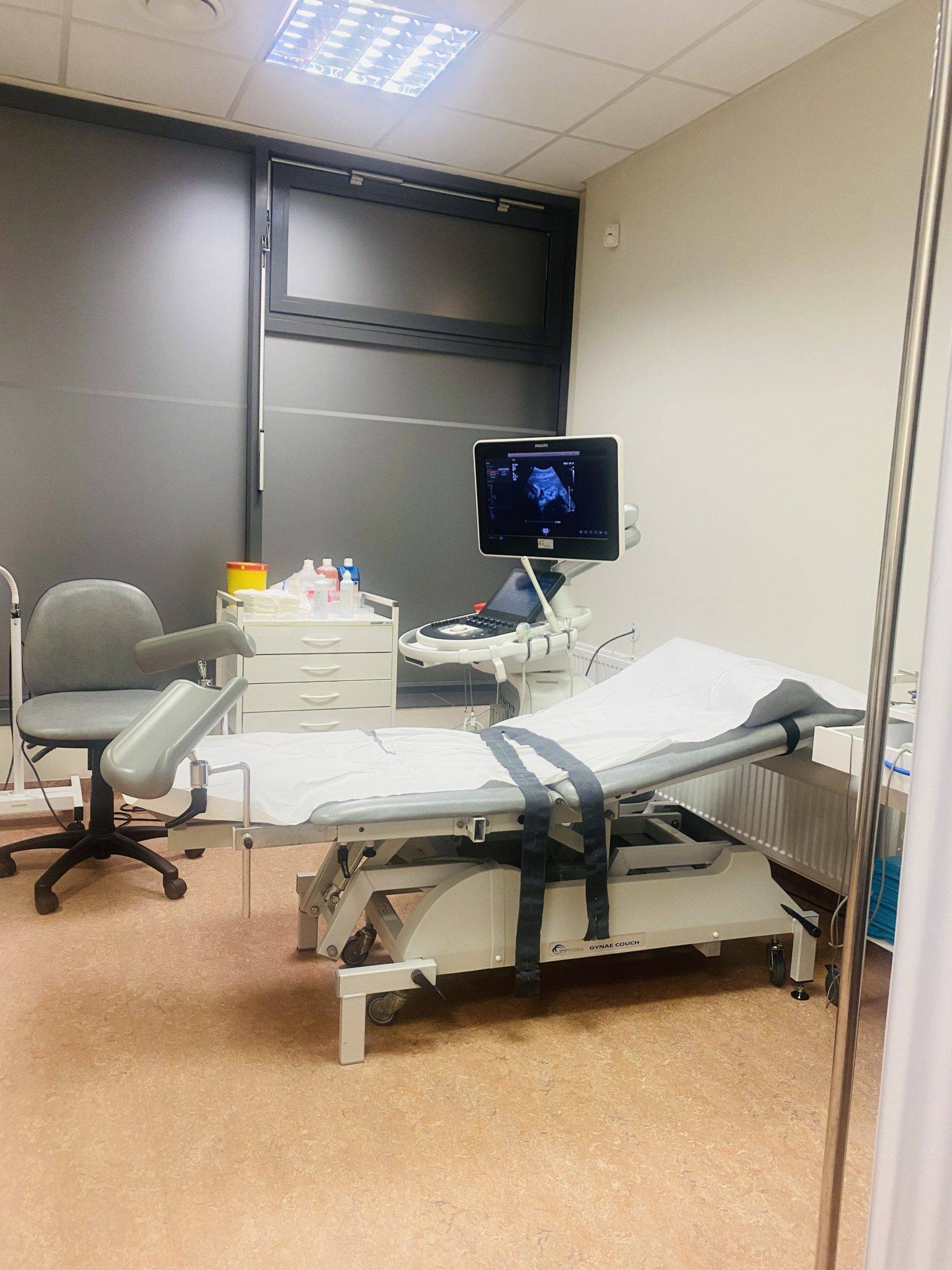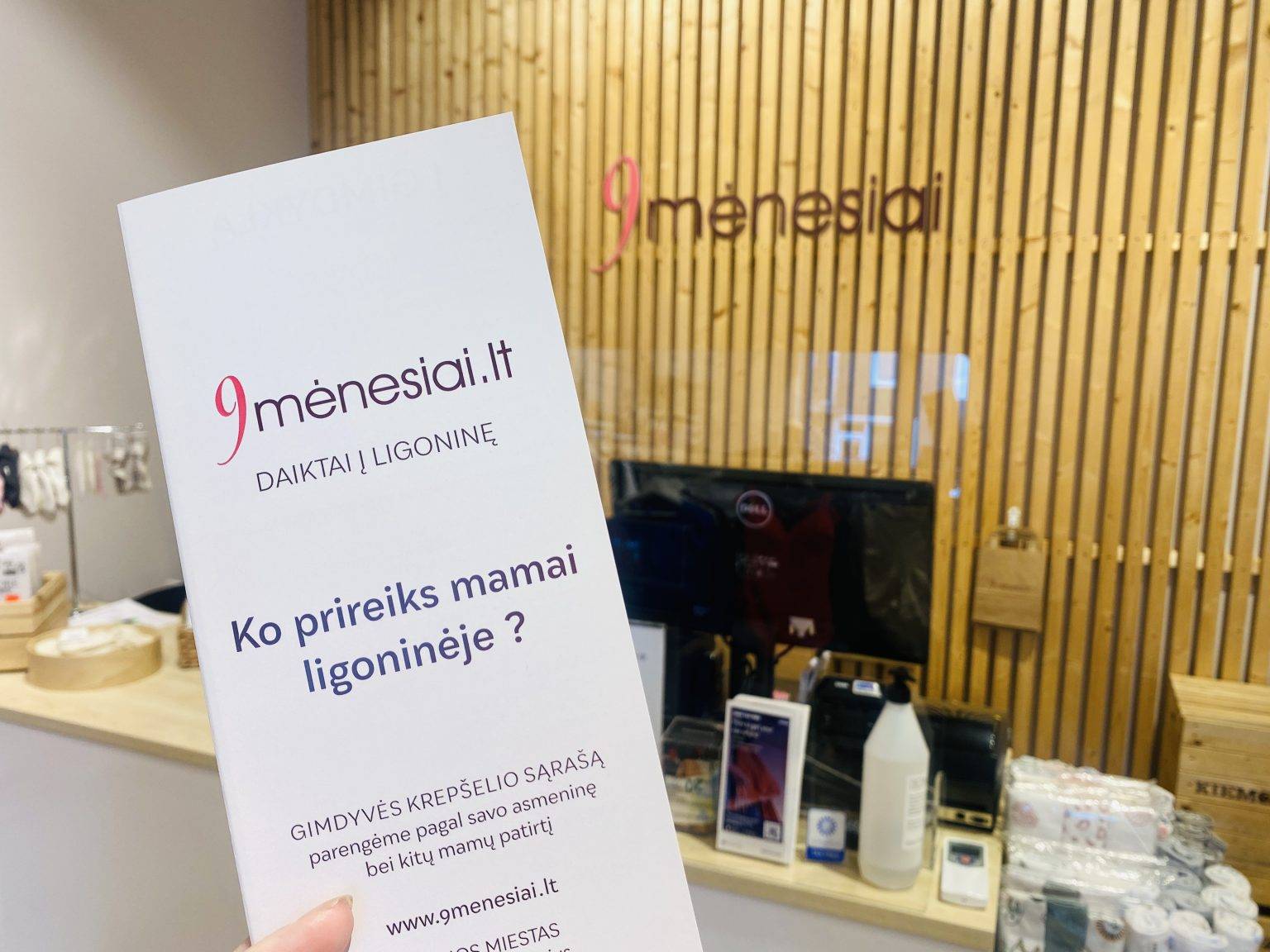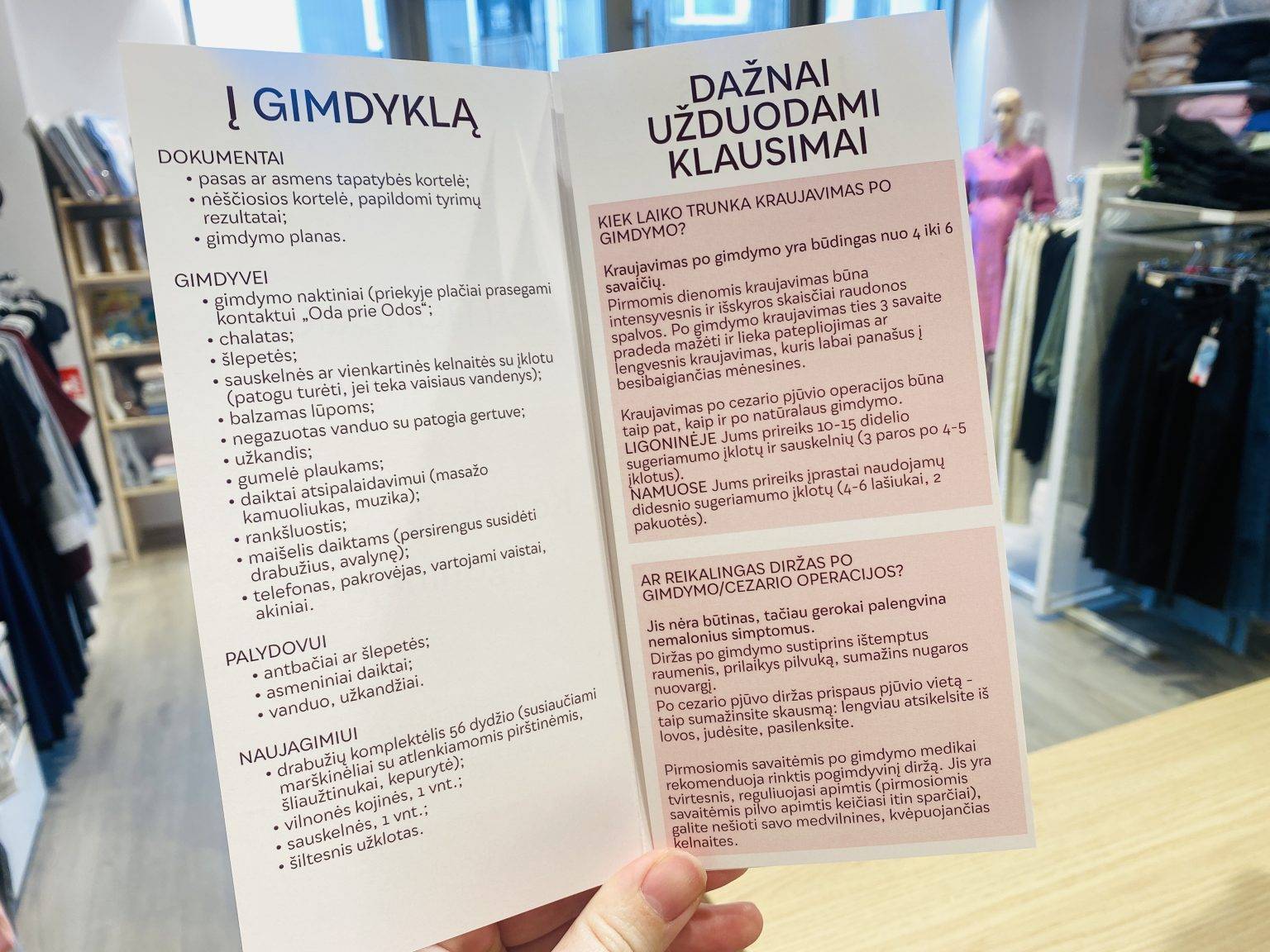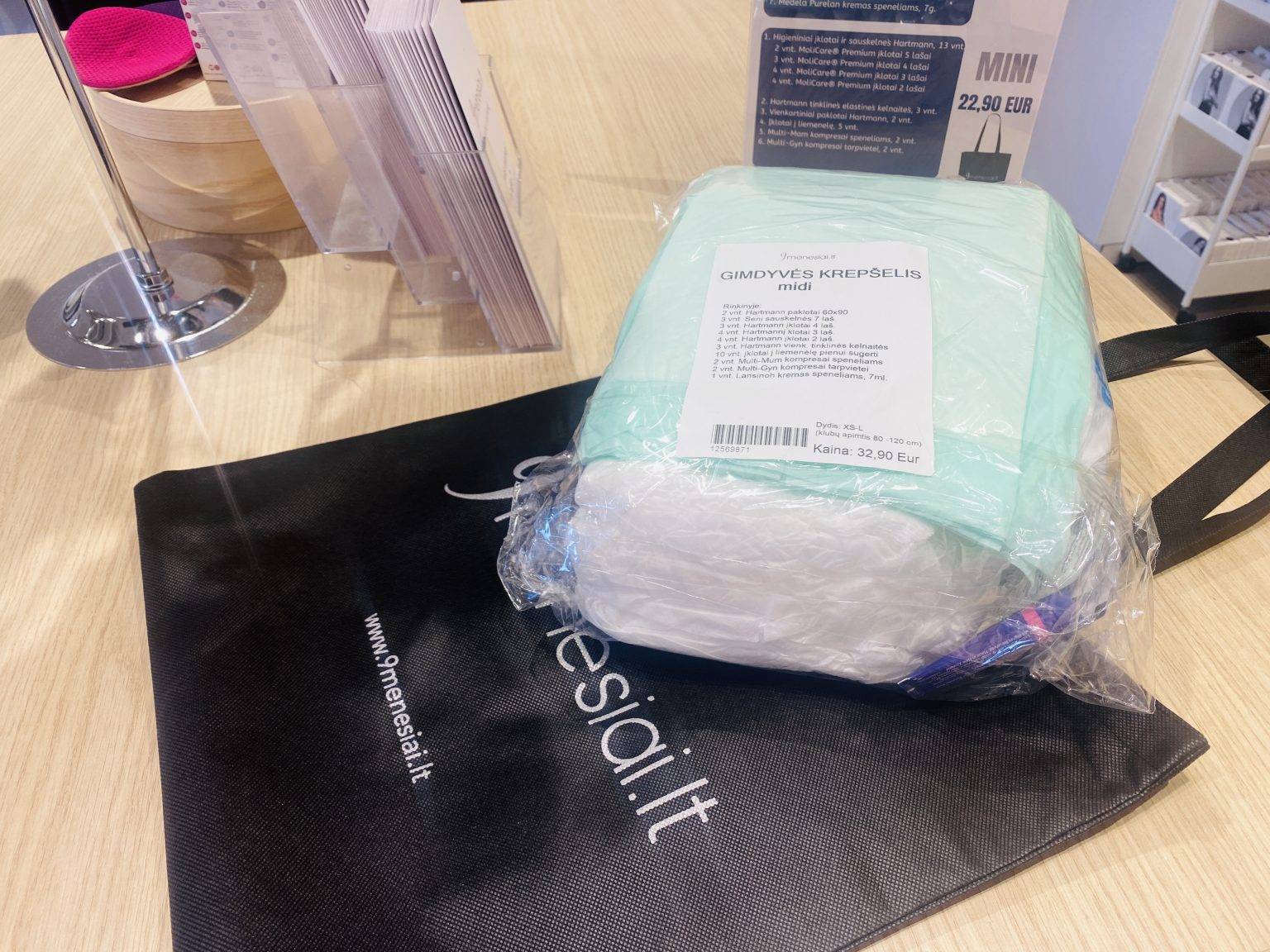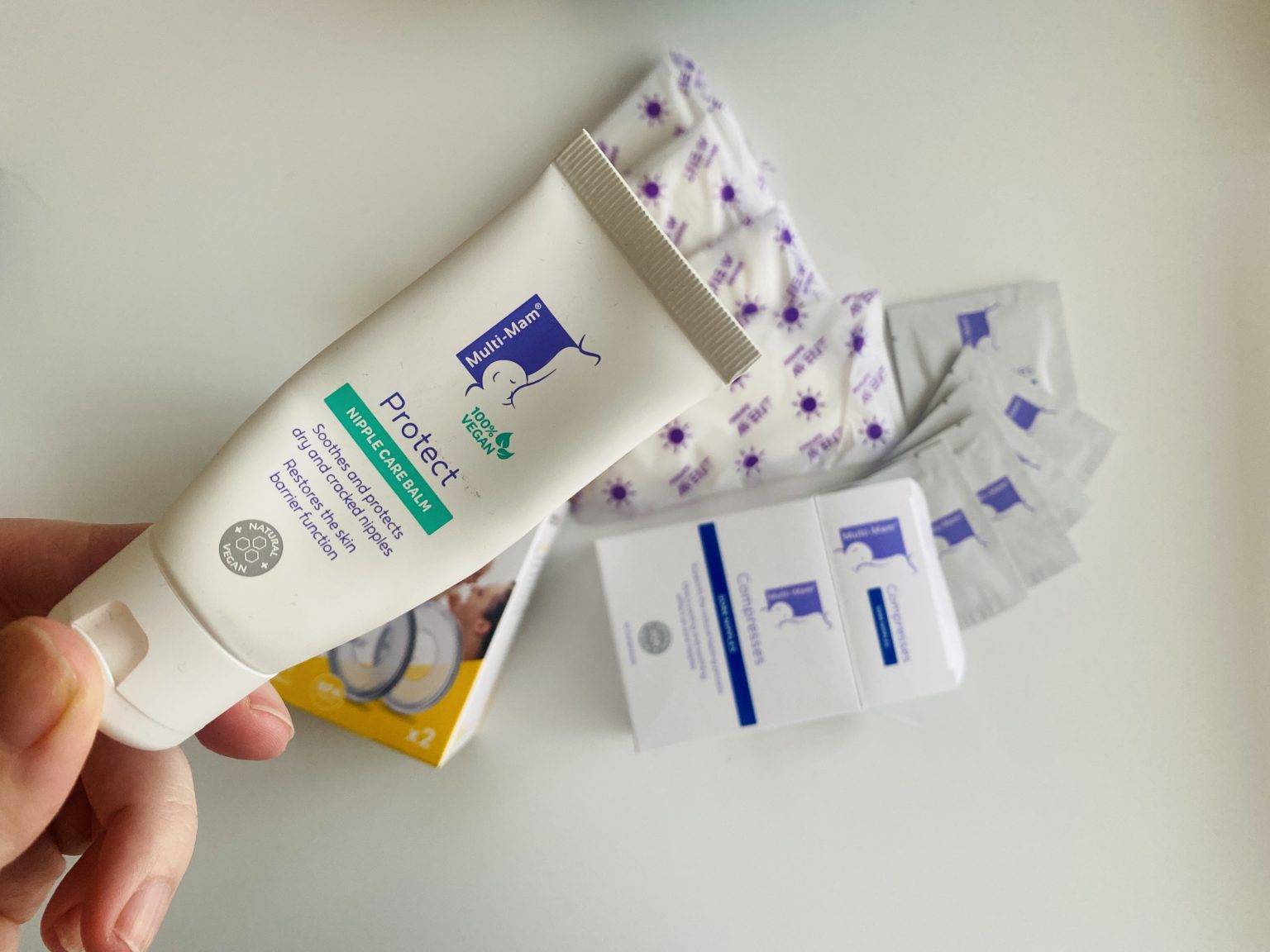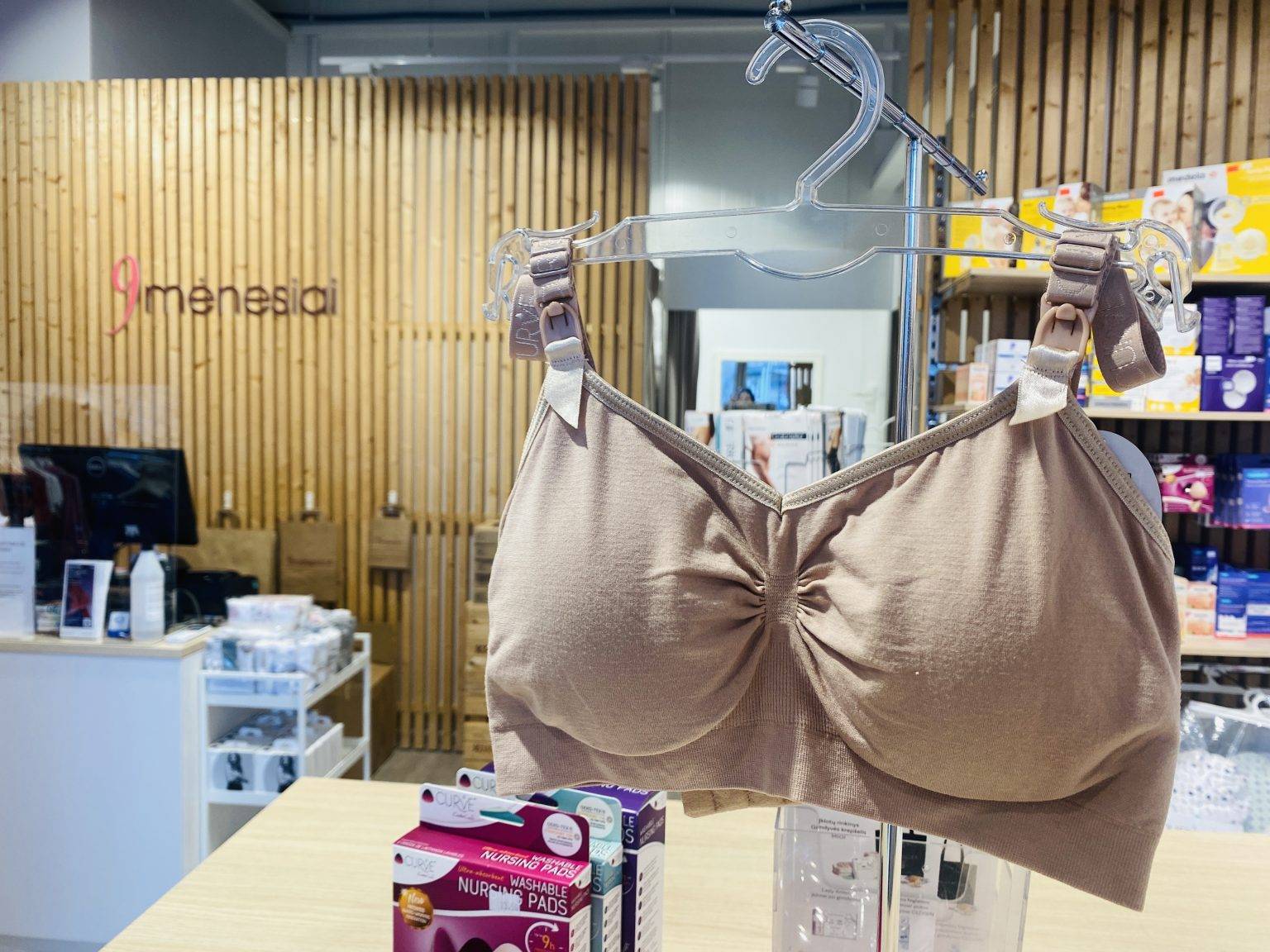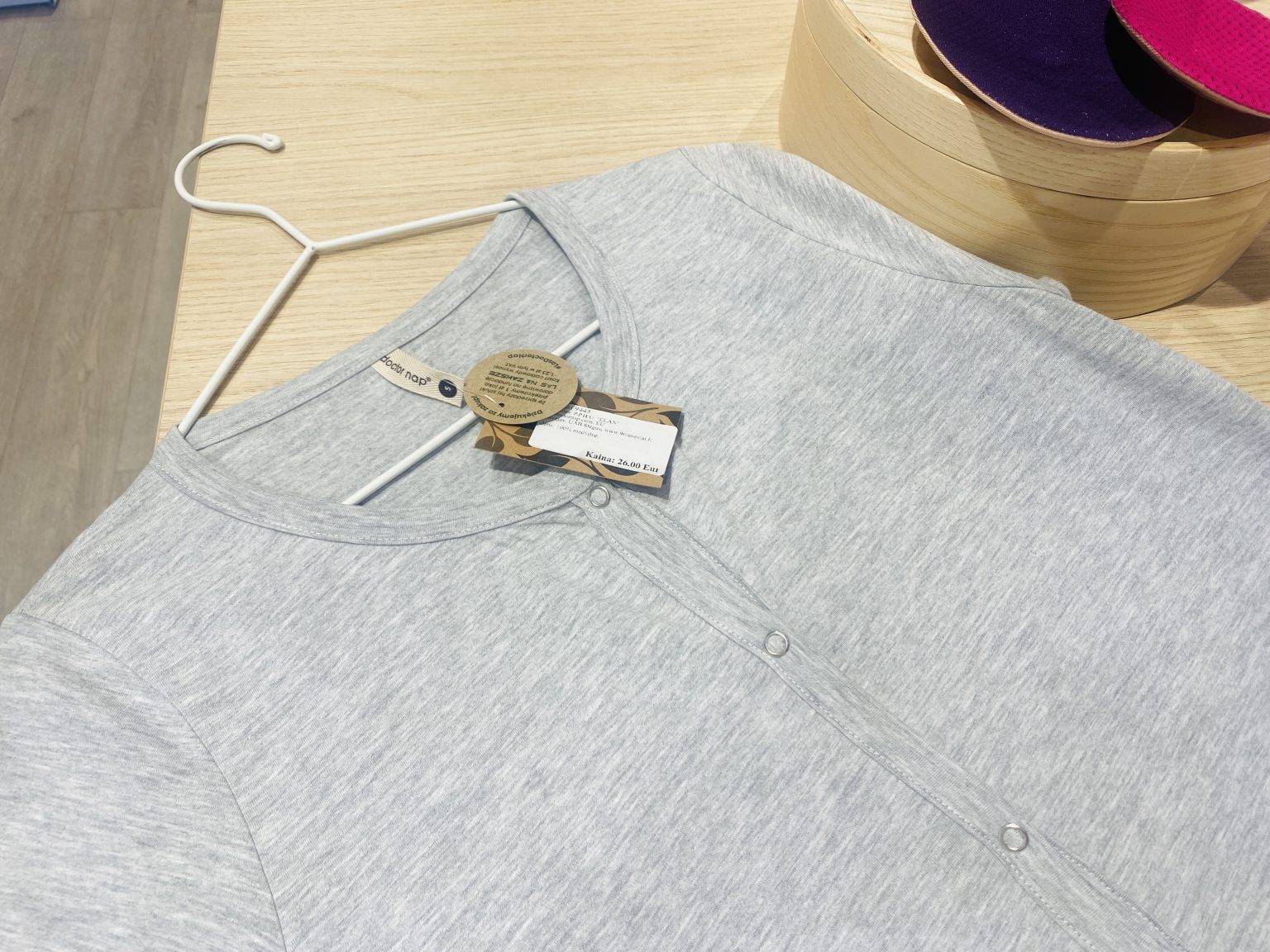Childbirth is one of the most unique and perhaps most worrying experiences in the life of a woman and her family. At “Travel 4 kids®” we write about travel, but this time we want to share the experience of giving birth at Santariskes hospital, rather than our impressions or recommendations for travelling abroad.
Paule, the little traveller, was born on 29 December 2022, just like our first son Motiejus, in Santariskes Hospital in Vilnius. As we have received many questions about the birth, the things needed and the doctor who delivered her, Agne will share more about the experience of giving birth at Santariskes hospital.
Agne wants to share her personal experience very honestly: why did she choose Santariskes Hospital, is it worth it to take a private room. What items and goods worked well, what was missing, what was not needed at all, and what she would do differently for a third birth. Very frank and honest, as a mother-to-mother.
In this article you will also find very simple information on arrival, parking in Santariskes, catering, items needed and other practical tips on giving birth at Santariskes hospital.
Giving birth at Santariskes Hospital (Obstetrics and Gynaecology Centre of Vilnius University Hospital Santaros Clinics). Why we chosed this hospital
I had to give birth in a level III hospital due to certain indications. This hospital in Vilnius is the Obstetrics and Gynaecology Centre of Vilnius University. However, even if I had not been obliged to choose a level III hospital, I would still have chosen giving birth at Santariškės. I gave birth to my first son, Motiejus, there.
However, the main reason why I was giving birth at Santariškės is that it is the best hospital in Lithuania. The Obstetrics and Gynaecology Centre of Santariskes Clinics itself has a newborn intensive care unit, where, if necessary, the baby would be given the help he or she needs after birth. Santariškės is also home to a Children’s Hospital with an intensive care unit, where critically ill or premature newborns are transferred from other hospitals and other cities. Giving birth at Santariškės gave me a special feeling of security. I knew that if my baby needed urgent help, I wouldn’t have to take him anywhere – he would be helped on the spot. It was also important for me to know that if something happened to my baby, I would be in the same hospital.
Giving birth at Santariskes hospital – delivery and recovery rooms
Childbirth in Santariskes takes place in the Obstetrics Department, where there are 11 individual delivery rooms, one of which is equipped with a birthing bath.
All recovery rooms are twin rooms. However, there are also family rooms where it is just you and your husband. There are not many of these rooms. You will only find out if you can get a family room on the day you go into labour.
Women who have given birth are placed in family rooms in order of preference, but please inform the staff when you arrive to give birth if you want a family room. As neither the staff nor you know when you will give birth, you will only find out about the availability of a ward after you have given birth. If there is a vacancy, you will get it, if not, you can ask to be moved when it becomes available. Let’s say you’ve been in a double ward for a day. As far as I have heard from the staff, these wards are preferred for mothers after C-section.
Prices
The cost per family is €63 or €73 (depending on the size of the room). In a family room, a man can stay as long as he wants, he can also sleep overnight, and there are two single beds. Meals are not provided for the husband. The two family rooms share a toilet and shower. Both times I was giving birth at Santariskes hospital I successfully got a family room. In my personal opinion, if you have the financial means to do so, choose the family room. You will have more privacy, peace and space for yourself and your baby. There is also a room called ‘Budapest’ in Santariskes. It costs 120 euros per night. It is more like a hotel room than a hospital room.
For meals. The meals are provided for you, but as I said, the meals are not provided for the husband. Both you and your husband can order food to your room from the Sotro café in the F-block (the food is really tasty by the way). It will be delivered directly to your room without you having to go anywhere. Read more about food delivery.
Giving birth at Santariskes hospital – arrival
My birth in Santariskes was planned, so I knew the exact day I was going to give birth and I was calmly preparing for it. The Obstetrics and Gynaecology Centre is located at Santariskes str. 2 F (new building). If you arrive at the hospital to give birth, you can ask a security guard to let you inside to get out closer to the entrance and unload your belongings. However, once you have done so, the man or person accompanying you must remove the car from the temporary area and park it in the car park. There are 11 Unipark parking lots near Santariskes Hospital. The most convenient is P5, which is opposite the Obstetrics and Gynaecology Centre and near the Children’s Hospital. The price of the parking spaces varies from 0.8 to 1.30 euro during the day and 0.3 euro cents at night. The daily price is €9.3.
If giving birth in Santariskes hospital is also your choice, when you arrive at the reception you will have to wait at the front desk (in the glass heated lobby) until you have been admitted for your check-up. An accompanying person will be waiting in the foyer with your belongings during the examination. The doctor will decide after the examination whether you are staying in the hospital to give birth or whether you are going home. If you stay to give birth and go straight to the maternity room, the man will be able to go with you straight away. If you are going to the pre-natal room (if your cervix has not opened enough, if you are induced or for other reasons why you do not need to go to the maternity room yet), your husband will not be able to stay with you.
PRACTICAL TIP
Your outdoor clothing and shoes will be collected at reception and handed over on departure. Men’s clothes are not taken, and you must wear slippers to the maternity ward, so have a separate bag and a bag in which to pack your husband’s outdoor shoes and clothes. Otherwise, you will simply have nowhere to put your shoes and jacket, and you will not be allowed inside the maternity ward with them unpacked or carried in your hand. And the general wardrobe in ward F does not accept shoes. And it is only open during certain hours. And after all, childbirth can take longer than you plan.
The hospital basket, when and how to put it together
Experts recommend that you pack your labour basket two months before your due date. This may seem early, but make sure you get the things you need before you have the energy and willpower to go to the shops or order online. Also, think about it: if you suddenly had to go away to give birth, would your husband be able to pack and bring all the things you need to the hospital?
There are three parts to a mother’s maternity basket. The first is the maternity basket for the mother and the baby’s first clothes, the second is the baby’s basket and the third is the mother’s basket. I recommend that you take only the first basket, the one for the maternity ward, with you when you arrive at reception. Your husband will be sure to bring the items for you and the baby after the birth.
If there are no complications, it will take you 2-3 days to give birth, so use the basket for that number of days. As I had to stay at the hospital for 5 days, my husband had to bring extra things.
RECOMMENDATION
As it was quite a task for my husband to find the things I needed at home, if I had to go to the delivery room again, I would leave the additional basket at home. This is in case I have to stay longer than planned at the hospital.
I packed my things for the hospital as well as for the trip in handy travel bags or IKEA zip bags. To make it easy to find for both me and my husband and not to get lost in a big bag. Also, my things and the baby’s things wouldn’t get mixed up. I bought most of my maternity and hospital supplies at 9 months.
Delivery room bag – what to take with you
I will discuss separately the composition of each maternity basket for the mother and the labour ward basket for the mother.
Essentials for the delivery room
The most important things you need to bring with you are your ID and your pregnancy card. For safety reasons, we do not recommend carrying a wallet with cards or large amounts of cash. If you need to pay for your room, you will need to do so when you leave the hospital. If you want food from a café, have some change.
If the doctors decide you’re in labour when you arrive, they’ll collect your outerwear and shoes from the examination room (to be returned when you leave). You will need to change into the clothes you will be wearing for the birth immediately, and you must bring your own.
The most comfortable ones are nightgowns, which can be fully unzipped and are suitable for skin-to-skin contact. I bought my nightgown together with my bathrobe. Later on, they will be perfect for breastfeeding. I had two nightgowns, one I gave birth in, the other I had to change after the birth when I was already in the post-natal ward, had a shower and recovered a bit. I bought this maternity nightgown. I still use them and I am very happy with them because they are very comfortable for breastfeeding.
Also have slippers. My personal recommendation is rubber slippers. They will be comfortable both on the ward and in the shower. You won’t have to bring two.
What else is important to take with you to the delivery room
Bring water, lip balm (at least for me personally, my lips were very dry). Personally, I found a small towel, which my husband used to wet with cold water, very helpful. I used it as a compress.
You should also take your post-natal diapers with you to the hospital. I had one left over from my first birth, but I bought extra because I needed them on the ward.
Take your baby’s first clothes (wool socks, a bodysuit, a pair of knickers or a onesie and a cap) with you to the maternity ward. I had brought my own baby blanket, but I didn’t need it because the staff provided a super soft minky baby blanket.
I also had a bathrobe for the transfer from the maternity ward to the room. It came from the kit I bought with my nightwear. I didn’t need anything else in the maternity ward.
I would take this bag and the baby’s first clothes with me when I went into labour. I’m sure the husband will be able to bring the rest of the things to the ward for you after the birth.
Mother’s hospital room bag – toiletries and medical supplies
I was very responsible with this part of the basket. And it was probably the biggest part of my suitcase. I share what it looked like, how much I had, how much I used, what was missing.
What I had with me and what I needed
- Diapers (I had one for the maternity ward, one for the ward, that’s all I needed);
- Disposable panties (I had three pairs, I used two);
- High-absorbency postnatal pads (I had a pack of 8, my husband bought extra). I really liked the Baboo brand. When choosing pads, make sure they are breathable, odour-repellent and made of fluff-free fabric. Change the pads often.
- Disposable bra pads (I had 10 pieces, used 8)
- “Multi-Gyn FemiWash” washing foam for intimate hygiene (I’ve been using it at home for a long time). And their small 100 ml packaging is also very handy. I particularly like these because I don’t have to transfer from a large 250 ml or 500 ml container to a small one. Also very convenient dosing). It is very important to pay attention to the ingredients when choosing an intimate hygiene wash during the postnatal period. It is important that it does not contain soaps that dry out the skin or synthetic fragrances.
- “Multi-Gyn” compresses. They are designed to relieve unpleasant sensations in the perineal and anal areas. They have a strong soothing effect in case of tissue damage, itching or irritation.
- Shampoo, toothpaste and toothbrush, deodorant (if you plan to breastfeed, start using unscented deodorant) and shower gel. You don’t really need extraneous odours, especially during skin-to-skin contact), face cream, comb and your usual and necessary cosmetics.
- Medicines or food supplements that you take.
- Wet wipes (I had a pack and that was enough).
Recommendation
It is very convenient to buy a maternity basket already made up. It contains all the necessary packages, as well as samples of hygiene products in small packets. So you will have a chance to try them out and if you like them, you will buy the big packs.
I didn’t buy the basket because I had leftovers from my first birth, some of which were given away by friends. I also use “Multi-Gyn FemiWash” in my daily hygiene routine.
What I had with me that I didn’t need
- Disposable sheets (I had a pack of 5, I didn’t need any because the hospital gave them to me);
- Shower gel bodies (the hospital had them);
- A box of disposable wipes (they were in the hospital).
What I didn’t have with me but needed
I DID NOT HAVE hygiene products and I needed. Nipple cream and compresses already on the first day after giving birth. As the breastfeeding journey with my first baby was very smooth, I did not need these products in the hospital, so I did not take care of them. After this birth, my husband went to the pharmacy in a hurry to buy them.
The beginning of breastfeeding with Paulė was difficult, the nipples became very sensitive, painful and cracked. While Paulė was learning to suck properly, I personally did not enjoy feeding my baby. After breastfeeding, the only thing that saved me was “Multi-Mam” compresses. Probably every expectant or breastfeeding mother has heard of them. I can honestly say that I didn’t really believe that they could help so much.
For me, these compresses were especially helpful a few days after giving birth, when the small amount of colostrum was replaced by a large amount of milk and the breasts were flooded with fluids to produce milk. They became hot and painful and it was these “Multi-Mam” compresses that helped me to relieve the pain and swelling. My midwife mentioned that they also prevent mastitis as a preventive measure. And most importantly, the remaining compresses do not need to be wiped off before breastfeeding. After removing the compress, you can immediately cuddle the baby at the breastfeed. The compress residue will not be harmful to the baby.
Qualified staff
I also really enjoyed my birth in Santariskes because of the very good postnatal care. Especially the very qualified staff, who were really helpful with advice and recommendations. As the private room had a fridge with a freezer compartment, I was very happy that the midwives provided me with an ice pack. I used it after feeding. When I went home, I couldn’t find an ice compress to buy, so I bought “Lansinoh Thera°Pearl 3 in 1” compresses. They performed the same function for me. I always use them cold. Now, after two months, I no longer need them, but I have them as a backup for everything.
“Multi-Mam” nipple cream, a product I used from the first days after giving birth and have used ever since. In the first days after giving birth, together with nipple compresses, it helps to relieve the pain. And now I use it as a protective cream to prevent the nipples from splitting and to keep the skin soft and healthy.
What I particularly like is that there is no need to wipe off the nipple cream before feeding.
My discovery and personal recommendation
As I mentioned in this article before, the beginning of the breastfeeding journey was difficult. I was suffering from extreme nipple pain. So I tried all possible measures to relieve the nipple pain (creams, healing compresses, ice packs). Because even without breastfeeding, I felt discomfort when my nipples touched my bra or pads. And after all, being bare-breasted all the time was not an option. But a young midwife recommended breast protectors. My husband as always quickly drove to the 9 months shop and bought Medela nipple protectors. That was my salvation. Because when wearing them, the nipples had no contact with the bra, but the ventilation holes allowed the skin to breathe and promoted nipple healing. I would recommend them to every mum. I now use this cap to collect milk during feeding and later refrigerate it for Paulė’s first porridges.
My sincere advice after childbirth is to try all possible products and goods that will help you recover and heal as quickly as possible after giving birth. Although these products are not cheap, they are the best investment. The sooner you recover and feel better, the more joyful motherhood will be. And you will be able to make the most of your baby’s most beautiful months, which will pass very quickly.
Post – natal ward bag for mom – clothes and other items
Clothing
Nightwear suitable for breastfeeding (front-buttoned, suitable for skin-to-skin contact). I had one for the delivery room and one for the room, and it was enough;
Breastfeeding bras (I had two and they were enough). I would recommend choosing a bra that is seamless, at least after the birth, and that can easily adapt to changes in breast size and does not press. This bra is my favourite. Later on, you will be able to choose a more ornate one, once you know exactly what size your breasts will be during breastfeeding. I would recommend having at least two nursing bras, as there will be leakage of milk. Also they need to be washed frequently for hygiene reasons. I have four. I got them all from the 9 months shop. Personally, the sleep bras recommended in the shop, which I hadn’t tried with my first son, Motiejus, were also very useful;
Bathrobe
Blouses with detachable shoulder straps (I had two in the hospital, which was enough). These blouses are my absolute favourite. I have four of them. They are my number one garment. I use them as an undershirt under a jumper or a sweater, as a sleeping blouse. They are very comfortable for breastfeeding. In fact, I cannot imagine breastfeeding without them;
Nursing blouse. I would recommend having at least one breastfeeding blouse that you can comfortably feed your baby while wearing. It will allow you to feed your baby effortlessly and comfortably at the hospital (which, by the way, you will have to go to at least once a month) and in other public places;
Trainers or leggings (comfort is the most important thing), a jumper (in case it gets colder in the ward) or just clothes that you feel comfortable with and wear at home;
Socks;
Other items
Towel for the body and a separate towel for the crotch;
Water, water, water. Although you need to drink water all the time, it is especially important after giving birth. At the beginning of breastfeeding, sufficient water is particularly important;
Snack. I didn’t have any, and after giving birth I really wanted to have a snack and regain my strength as soon as possible. The hospital cafeteria was no longer open, so my relatives had to go to the shop;
Blanket. I needed it to keep me cosy and to wrap myself in during skin-to-skin contact.
The most amazing doctor Romoaldas Jursenas
One more reason why I would never even think of choosing to give birth anywhere other than in Santariskes is the doctor working there. I gave birth to both Motiejus and Paule with the most wonderful doctor in the world, Romoaldas Jursenas.
His compassion, calmness, constant encouragement and, of course, professionalism are incredible. I felt calm throughout the whole birth, I knew I was in the best possible hands. After the birth, the doctor visited me every day, asked me how I was doing and gave me advice.
After both my first and second deliveries, I couldn’t find the right words to thank this doctor for giving me two of the most wonderful children in the world. And when I said goodbye to the doctor, I couldn’t hold back my tears. I am eternally grateful to him for his help and care when I had to come back from the hospital a few days after discharge with uterus inflammation.
Paule’s birth was also attended by a fantastic midwife, Oksana, whose last name I unfortunately cannot remember. It is hard to believe how a person can work with such dedication and love. With her support, both physical and moral, I felt as if my mother was present at the birth alongside my husband.
Giving birth in Santariskes hospital – a truly wonderful experience
During the five days I spent in the hospital, all the staff were extremely qualified and professional. I was particularly impressed by the young midwives working in the postnatal wards.
The modernity of the maternity wards and wards at the Santaros Clinics Obstetrics and Gynaecology Centre probably needs no introduction. The wards are new and modern. There are tablets by the beds with internet access.
I would definitely recommend Vilnius University Hospital Santaros Klinikos Obstetrics and Gynaecology Centre for giving birth. Because of the professionalism of the doctors, the modernity of the wards, and the post-natal care of mothers and newborns. And, of course, because of doctor Romoaldas Juršėnas. I sincerely wish that every mother would give birth under the care of such a wonderful doctor. Giving birth in Santariskes was the best decision for me and for our whole family.
And I would definitely and wholeheartedly recommend every mother to visit the 9 Months store. Especially if you have the opportunity – the physical one in Vilnius. Because you will get really sincere advice on choosing the things you need for pregnancy, childbirth and the postnatal period. And if you don’t have the opportunity, you can order everything online without any problems with a telephone consultation. The 9-month home delivery basket contains everything you will need in hospital. I am sure that good preparation for the birth will make you feel calmer and safer before the upcoming birth.
Even after the birth and pregnancy, I visit the 9 months shop to buy breastfeeding clothes and bra pads.
Giving birth in Santariskes was and is a wonderful experience, and I wish it for every mother.

